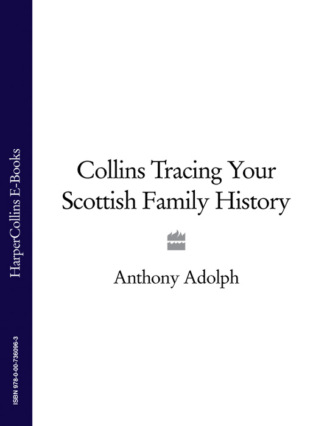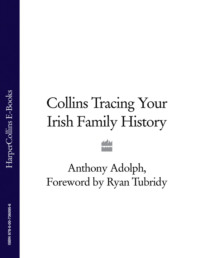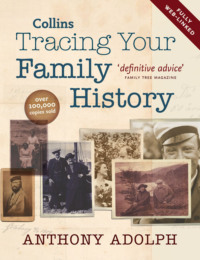
Полная версия
Collins Tracing Your Scottish Family History
I prefer hand-writing family trees and keeping more detailed notes in computer ‘word’ documents. The following ‘narrative’ method allows much flexibility:
Alexander Matheson
Write everything you know about Alexander. Then write ‘his children were’ and list them:
1 Donald Matheson, the next member of the direct line, so after his name type ‘see below’
2 Alexander Matheson. Put anything you know about Alexander and his descendants here. If he had children, then write ‘his children were:
1 Hamish Matheson.
2 James Matheson: if he had offspring, then…
1 Jean Matheson
3 Margaret Matheson. If you have absolutely loads on Margaret and her descendants, you might want to open a separate ‘chapter’ for her and put her at the top of her own narrative document.
Donald Matheson, son of Alexander.
Write what you know about Donald, and so on.
Since 2002, however, these records have become available on www.ScotlandsPeople.gov.uk. This is run by the General Register Office for Scotland (GROS), the National
Archives of Scotland (NAS), the Court of the Lord Lyon and an internet company, Brightsolid. You purchase a block of credits using a credit or
Pedigree conventions
• = indicates a marriage, accompanied by ‘m-’ and the date and place.
• solid lines indicate definite connections: dotted lines indicate probable but unproven ones.
• wiggly lines are for illegitimacy (though straight lines are now acceptable) and ‘x’ for a union out of wedlock.
• loops are used if two unconnected lines need to cross over, just like electricians’ wiring diagrams.
• wives usually go on the right of husbands, though only if that doesn’t interfere with the chart’s overall layout.
• Common abbreviations are:
b. born bach. bachelor bpt. or c. baptized or christened (same thing) bur. buried d. died d.s.p. or o.s.p. died without children d.v.p. or o.v.p. died before father inft infant m. married MI monumental inscription m.i.w. ‘mentioned in the will of…’ followed by f. for father, gf. for grandfather and so on. m. proc. marriage proclamation spin. spinster test. testament unm. unmarried wid. widow or widower (as appropriate) w.wr./pr. will written/proveddebit card, and spend them making searches and viewing digital images of the records themselves. Searching the index to wills and testaments is free but you pay to view an image of the document. At the time of writing, the site contains the following material:
• Statutory (General Register Office) Registers: Births 1855-2006; Marriages 1855-2006; Deaths 1855-2006.
• Old Parochial Registers: Births and Baptisms 1553-1854; Banns and Marriages 1553-1854.
• Censuses: 1841, 1851, 1861, 1871, 1881, 1891, 1901.
• Wills and testaments: 1513-1901.
If, by the time you use the site, more material has been added, all well and good!
Births, marriages and deaths are indexed up to nearly the present day, but for privacy reasons, digital images are only available up to 100 years ago for births, 75 years ago for marriages and 50 years ago for deaths, though you can order ‘extracts’ of these from GROS, or examine the originals at the ScotlandsPeople Centre.
The website works out more expensive than visiting the archives in Edinburgh, but if you don’t live nearby then www.Scotlands People.gov.uk is a godsend. Besides bringing indexes to your computer, it has indexed the indexes, making the searching process vastly easier than ever before. And, because it’s now possible to view images of the original documents online, people across the globe can now trace their Scottish ancestors properly. This has encouraged many new people to start exploring their Scottish roots.
Take a few minutes to explore the site’s extra features. There are fairly detailed explanations of the records, and ‘Research Tools’ contains many helpful features, such as tips on reading old handwriting and understanding old money.
The calendar
Up to 1582 Britain and Europe used Julius Caesar’s calendar, with years starting on Lady Day, 25 March, but that year many Continental countries started using the calendar of Pope Gregory the Great, with years starting on 1 January. King James VI and I ordered the adoption of the Gregorian calendar starting on 1 January 1599/1600, and now that the year started in January, not March, New Year quickly absorbed many surviving pagan Winter Solstice traditions, creating the great Scots New Year festival of Hogmanay. Although James became king of England and Ireland in 1603, the calendar there did not change until 1752.
Dealing with written records
Reading old handwriting is called palaeography. Old ways of writing, or simply bad handwriting, present a real problem for genealogists. You can learn to read the former, but ghastly scrawls can defeat the most seasoned professional. For old hands, see G.G. Simpson’s Scottish Handwriting 1150-1650 (Tuckwell Press, 1973) and A. Rosie’s Scottish Handwriting 1500-1700: a self-help pack (SRO and SRA, 1994).
www.scottishhandwriting.com offers online tuition on old handwriting, and there are palaeography classes available elsewhere, especially at the ScotlandsPeople Centre.
Older records in Latin can be off-putting, but you can always pay a translator or experienced genealogist. Good guides to Latin include R.A. Latham’s Revised Medieval Latin Word-list from British and Irish Sources (OUP, 1965), and there is a useful list of Latin words used in genealogical documents at www.genuki.org.uk. Here are some basics that appear in legal documents:
• Annus year • Dies day • Eod. die. same day • Est is • Filia daughter • Filius son • Inter alia amongst others • Mater mother • Matrimonium married • Mensis month • Mortuus died • Natus born • Nuptium married • Obit died • Parochia parish • Pater father • Pro indiviso undivided • Qua as • Sepultat buried • Uxor wife • Vide see • Vidua widow
This extract from a nineteenth-century sasine or land grant is relatively easy to read: earlier documents can be harder to follow.
Knowing what a document is likely to say can help enormously. Examples of old documents, highlighting where to find the genealogically relevant parts, are in P. Gouldesborough’s Formulary of Old Scots Legal Documents (Edinburgh, 1985).
If you’re stuck over a word you cannot read, look for others in the document that you can. By doing so you can work out how the writer formed each letter, and you can use this technique to decipher otherwise illegible words.
CHAPTER 2 Archives and organizations
Before you start research amongst records, it’s sensible to have a good idea of where to find the records you will need, online or on the ground. Here is an overview.
Edinburgh
Many of Scotland’s records are found in Edinburgh. The main port of call there is the new ScotlandsPeople Centre, opened in 2008, and housed in two adjoining, venerable institutions at the end of Princes Street, New Register House (home of the General Register Office or GROS), and General Register House. The Centre has several searchrooms, including disabled access, and offers a free two-hour ‘taster session’ each day for newcomers.
Visitors are allocated a computer terminal for a fixed daily fee (currently £10), or you can pay an hourly rate for expert help. Via the terminals you can search broadly the same material that is available on www.ScotlandsPeople.gov.uk – General Registration records, censuses, Old Parochial Registers (OPRs), testaments and wills to 1901, and the Public Register of All Arms and Bearings (not yet on the website). The terminals can save up to 200 images, that can be downloaded to a memory stick for a fee, or returned to on a later visit. Check the website for the Centre’s opening times and details of how to book.

The old Sasine Office of the National Archives of Scotland, now the entrance to the Historical Search Room.
The original heraldic records are in the Court of the Lord Lyon, on the first floor of New Register House www.lyon-court.com.
General Register House is one of the two buildings of the National Archives of Scotland (NAS, formerly the Scottish Record Office or SRO), containing many national and local records. Here are located the Legal Search Room and the Historical Search Room; the latter being the one most frequented by genealogists. The NAS’s other building, West Register House, home to its maps and court records, is a mile (1.6 kilometers) away in Charlotte Square. The NAS’s official guide is Tracing your Scottish Ancestors (NAS, fourth edn, 2007) which, despite its title, is mainly concerned with its own holdings. The NAS website includes its catalogue (called OPAC, the Online Public Access Catalogue) and guides to the records at www.nas.gov.uk/guides/. You can simply key a place name or family name into the catalogue and see what appears – usually a great deal. To hone searches, choose specific time periods or categories of record. To find the kirk session records for a specific parish, for example, you would key in the parish name followed by the reference CH2.
The National Library of Scotland (NLS, www.nls.uk) contains many useful journals and books, as does Edinburgh City Library, which also has a good collection of Scottish newspapers. The NLS Map Library is in Salisbury Place, and its collection is now accessible online at www.nls.uk/maps/index.html.
Archives across Scotland
Scotland is well supplied with local archives, business and institutional archives. There is an increasing number of small visitor centres catering to local interest in history and genealogy, and to genealogical tourists, such as the Comainn Eachdraidh or Western Isles Historical Societies. For addresses, see the slightly out-of-date Exploring Scottish History (M. Cox, ed, Scottish Library Association, 1999), or look at the tourist information website www.visitscotland.com/ under ‘visitor attractions’.
At present 52 archives are linked in the Scottish Archive Network (SCAN), whose catalogues can be accessed at www.scan.org.uk. It’s worth looking at the site’s ‘knowledge base’ that has information on all manner of things from old legal terms and old money to a gazetteer of ‘problem places’ (SCAN includes www.scottishdocuments.com, whose records, slightly confusingly, are accessible via ScotlandsPeople).
Other websites useful for locating archives and records are:
Edinburgh addresses
GROS and the ScotlandsPeople Centre
New Register House,
3 West Register Street,
Edinburgh,
EH13YT
www.gro-scotland.gov.uk
The National Archives of Scotland (NAS)
HM General Register House
2 Princes Street
Edinburgh
EH13YY
www.nas.gov.uk
National Library of Scotland
George IV Bridge
Edinburgh
EH11EW
www.nls.uk
Scottish Life Archive
National Museum of Scotland
Chambers Street
Edinburgh
EH11JF
www.nms.ac.uk
See also pages 215-17 for more useful addresses.

The websites of the National Archives of Scotland and the General Register Office of Scotland.
www.archon.nationalarchives.gov.uk – covering local archives, museums, universities and similar institutions.
www.familia.org.uk – public library holdings of genealogical material.
www.archiveshob.ac.uk – focuses on holdings of academic institutions.
Before visiting any archive, always check its website or telephone for opening times, what identification you may need, fees charged, and whether you need to book. Also, make sure that the records you are planning to search are likely to tell you what you are hoping to find out – this guide should help you do that.
The National Register of Archives of Scotland
The NRAS (www.nas.gov.uk/nras) catalogues privately- or publicly-held papers of many individuals, families, landed estates, clubs, societies, businesses and law firms. Its online catalogue is particularly useful for finding estate papers of families who may have been your ancestors’ landlords, or archives of businesses that may have been your family’s employers.
Genealogical Societies
The Scottish Genealogy Society (www.scotsgenealogy.com) was founded in Edinburgh in 1953 to promote research into Scottish family history and to encourage the collection, exchange and publication of material relating to Scottish genealogy and family history. It has an excellent library, keeps a register of people researching specific surnames, and publishes a quarterly magazine, The Scottish Genealogist.

The old kirk at Inchnadamph, Sutherland, now beautifully restored by Historic Assynt (www.historicassynt. co.uk) as a focal point for studying the genealogy and history of Assynt.
The Society of Genealogists (SoG) in London has a vast collection of printed and manuscript sources covering all the British Isles, including a great deal for Scotland. A summary of its Scottish holdings is at www.sog.org.uk/prc/sct.shtml. Its largest manuscript collection is The MacLeod Collection, comprising the working papers of Revd Walter MacLeod and his son John, both professional genealogists in Edinburgh from about 1880 to 1940. Its 83 boxes are in rough surname order, though seem to contain mainly notes, not finished reports.
The GOONs or Guild of One Name Studies (Box G, 14 Charterhouse Buildings, Goswell Road, London EC1M 7BA, 0800 011 2182, www.one-name.org) includes many members studying Scottish surnames.
Scottish family history societies can be found via Genuki (see p. 33) or the Scottish Association of Family History Societies on www.safhs. org.uk. The latter publishes much of local interest and members can be funds of local lore. Many family history societies in Australia, New Zealand and the Americas, incidentally, have Scottish-interest groups, and there are Scottish Societies, including strong genealogical elements, in many countries. The Netherlands, for example, has a flourishing Caledonian Society (www.caledonian.nl) whose members are mainly descendants of Scots sailors, soldiers and merchants who settled in the Dutch ports.
Most Scottish clans now function through clan societies, that are effectively family and social history societies, as described on p. 160.
Though not really a ‘society’, www.rampantscotland.com is an American website providing copious links to Scottish-interest sites, including travel, cooking, clans and history. The genealogy links page is worth exploring.
Seallam!

The Seallam! Visitor Centre, and its founders, Bill and Chris Lawson, with their fantastic files of island pedigrees.
A fine example of a small local archive is Bill and Chris Lawson’s Co Leis Thu? (which means ‘what people do you belong to?), housed at the Seallam! Visitor Centre, An Taobh Tuath (Northton), Isle of Harris, HS3 3JA, 01859 520258, www.seallam.com.
Realizing that the fantastic oral history surviving amongst the Gaelic speakers in the Hebrides was threatened by the spread of English, Bill learned Gaelic and approached as many Gaelic speakers as possible. Few were willing to talk on tape or even in front of a notebook, so he had to remember what he heard, and record it later. He combined the results with close scrutiny of the available written records. Of these, he comments,
‘Written records in the Islands are generally poor, and were often kept by incomers with no knowledge of Gaelic, and even less interest. Oral tradition, on the other hand, comes from within a community and is much more likely to be accurate, even though it does tend to me more localized. Neither by itself is a complete record, but if the two are amalgamated, a more complete picture emerges, sometimes with surprising results…’
None more so than in the wonderful cases of people who could recite their patronymics – their father’s name, followed by their grandfather’s, great-grandfather’s, and so on. Some patronymics also appear in written records (albeit with rather odd attempts at transliteration), such as parochial registers. Bill says, ‘It can take some patience to recognize John Mcoil vicunlay vicormett as Iain macDhomhnaill mhic Fhionnlaidh mhic Thormoid – John son of Donald son of Finlay son of Norman,’ though of course the effort is entirely worth it as, in this case, it provides a four-generation pedigree.
The main records to which he tried to link oral pedigrees were the census returns, which are theoretically complete. Onto this dual peg, Bill could then hang any other information available – civil registration, parochial registers and so on. The results are astonishing – over 10,500 pedigree sheets, each neatly drawn out in immaculate handwriting, covering all the families of the islands of the Outer Hebrides (Harris, Lewis, Barra, North and South Uist and the smaller associated islands). As the 1851 census includes the elderly, many of these pedigrees go back to the late 1700s.
Bill’s main clients (he makes his information available for a very modest fee) are descendants of the islands’ many late eighteenth- and nineteenth-century emigrants. Some Lewis and Harris sheep farmers went as far as the Falkland Islands and Patagonia, but most Lewis people went to eastern Quebec and Bruce County, Ontario, later ones making for the Gaelic-speaking areas already colonized by their kin, whilst Uist and Harris people set sail for Cape Breton and Prince Edward Island, and from 1850s onwards to Australia. Judging by where they settled, Bill often has a head start working out where they would have originated. Sometimes there are clues in the emigrant communities, reminding us that our ancestors lived in extended families, and that we should always look beyond the narrow confines of our direct ancestral lines. Thus, MacDonalds on their own may be fairly ubiquitous, but MacDonalds mixed with Steeles indicate migrants from South Uist (where the surname was adopted by a group of MacLeans who wanted to disguise their identity from some vengeful Campbells: they chose Steele simply as it was the boat’s skipper’s surname).






